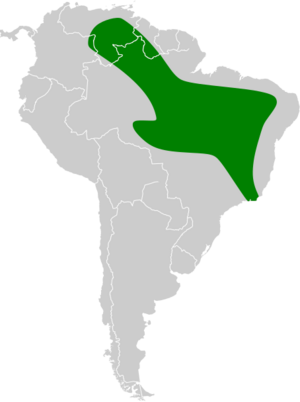Mato Grosso dog-faced bat facts for kids
Quick facts for kids Mato Grosso dog-faced bat |
|
|---|---|
| Conservation status | |
| Scientific classification | |
| Genus: |
Neoplatymops
|
| Species: |
mattogrossensis
|
 |
|
| Synonyms | |
|
|
The Mato Grosso dog-faced bat (Neoplatymops mattogrossensis), is a bat species found in South America. It is the only species in the genus Neoplatymops.
Taxonomy and etymology
It was described as a new species in 1942 by C. O. C. Vieira. The holotype was collected along the Juruena River north of the Brazilian state of Mato Grosso.
Description
It is a small species of free-tailed bat, with a forearm length of 29–30 mm (1.1–1.2 in) and weighing 7–7.5 g (0.25–0.26 oz). It is sexually dimorphic, with males larger than the females. Its skull has a flattened appearance. Its dorsal fur is brown, while its ventral fur is white or gray. Both males and females have gular glands. Its dental formula is 1.1.2.32.1.2.3 for a total of 30 teeth.
Biology and ecology
The Mato Grosso dog-faced bat possibly has a harem social structure. In Venezuela, colonies consist of a single male and two to four females. It is a seasonal breeder, with females giving birth once per year at the beginning of the wet season. It is insectivorous.
Range and habitat
It is found in several countries in South America, including Brazil, Colombia, Guyana, and Venezuela.
Conservation
As of 2008, it is evaluated as a least-concern species by the IUCN—its lowest conservation priority.


